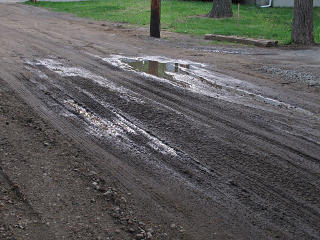
That minor factoid became important later on.
|
Things went quiet for a few days, but behind the scenes various resources
were being lined up and schedules filled in. A roadwork operation takes
good coordination between several different entities.
[Thumbnail pictures are linked to larger ones.] |
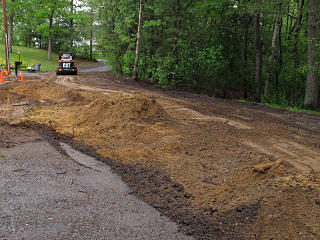
|
They continued working the hump for a while, pushing most of the material down-slope to level the downhill side of the intersection as well. That's why this process is called "cut and fill"... |
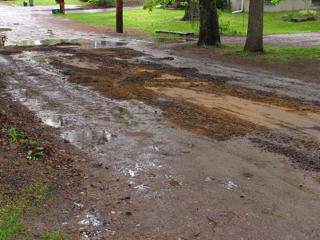
|
A brief attempt was made to bring some of the dirt over and fill in the muddy area a little, but this was soon decided to not be worthwhile as main grading was about to fix all that anyway. |
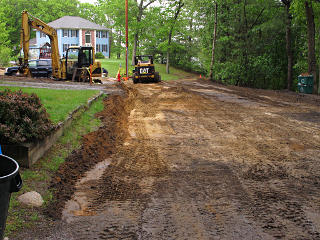
|
A fairly severe cut into the closest abutter's front lawn was needed, but fortunately it already had a retaining wall of railroad ties so they didn't have to re-engineer a slope. |
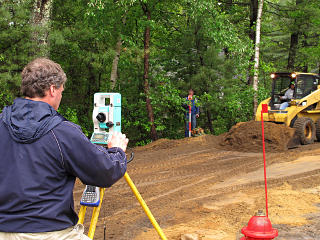
|
A survey crew from the engineering company arrived to re-establish the exact road boundary limits, which had been done several months before but only in a rough way and many of the old marker stakes were already missing. This was a more thorough run to lay out the exact lines for the revised plan. As I half-heard them talking on the radio I realized that they were working with very fine position differences that the transit was able to distinguish at hundreds of feet away, such as the guy at the reference marker saying "move 2 inches to your left and 3 towards me". |
| They were using a Nikon/Trimble DTM-521, an instrument referred to as a "total station" that not only shoots distances and angles at something better than 3 seconds of arc resolution, but does most of the math needed right on board to determine linear distances between arbitrary points where the reflector pole is moved to. I couldn't find a manual for this specific model but this one for the DTM-502 is very similar and describes how they work. Two known reference points were enough to determine all the rest of the ones they needed. | |
Return to dirt
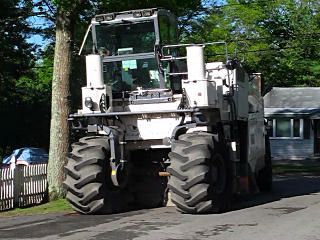
|
They wasted no time getting started, as this piece of equipment is in
high demand for other jobs around the area. The machine is a
Wirtgen WR2500-S referred to as a soil stabilizer, but there's little
technical difference between "cold recycling" of bituminous paving or
other top-layer material and making sure the soil base underneath is
of a known uniform consistency. The mechanism is the same. These
machines and the surrounding methodology are becoming much more mainstream
in modern repaving operations, as they are fast and generate no waste.
The picture here links to a short video; click to download or play it. There's a better and longer HD video here of the same type of machine running, that someone in some western-US locale took during high-altitude mountain road work. |
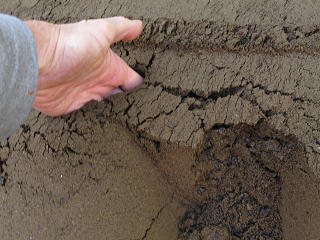
|
The output is very soft, and would obviously need to get rolled down again to form the new substrate layer. |
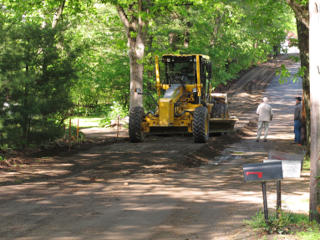
|
The grader could now start merging some of the recycler output into the rest of the dirt stretch, building a more uniform slope from the hill down toward the engineered lowest point. |
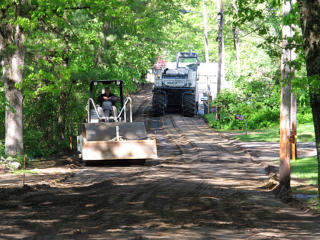
|
A little preliminary roller compaction was done on the loose stuff, but there would be much more of this later on. Even after that, the recycled part was still sitting above the original surface. |
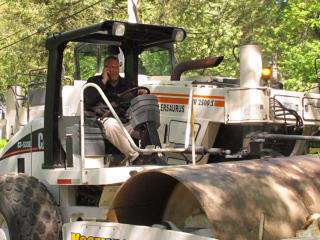
|
Hang up and roll ... |
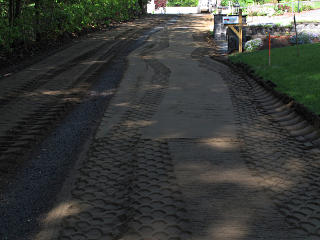
|
The second recycler pass established the other edge of the roadbed, leaving just a narrow strip in the middle. |
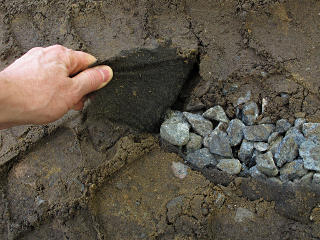
|
As a result, some of the filter cloth got ripped up and exposed the drainage stone. Not good; the grade would need to leave substantially more dirt over all this. |
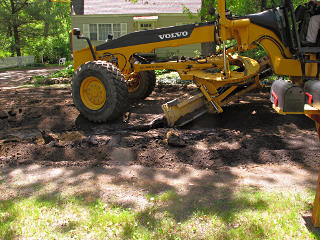
|
As the grader tried to work this a little more, an additional headache appeared in the form of more old pavement, buried under the dirt area, that nobody had any idea was there! |
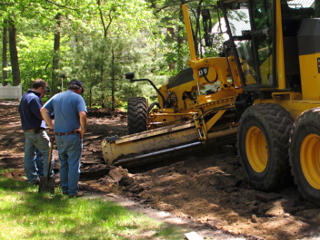
|
So the guys were like "okay, now what do we do with this". The reclaiming machine was long gone by then, so having it recycle more of the roadbed wasn't an option. |
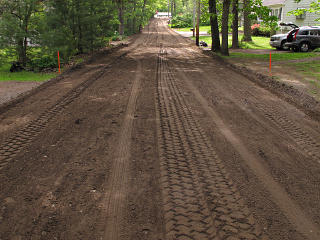
|
Despite the minor setbacks, a workable basic grade was established toward the end of the day and the path that water would take toward the catch basins wasn't compromised. |
Shakin' all over
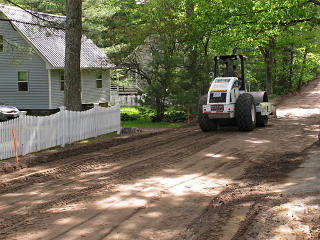
|
Then came the part that had me terrified. A lot of vibratory compaction had been done on the subdivision roadbeds some months before, which rattled the crap out of all the abutters' houses even at some distance away. Code requires this to stabilize any disturbed base soil under paving so they had to do some quantity of it, but I was concerned enough about what might happen when it was right in front of our houses that I filed an official letter with the town hall Planning staff and even escrowed a batch of "before" pictures with them from all around my foundation as proof of pre-existing conditions should it become necessary. |
|
I read up on the subject a bit. I asked about any possibility of seismic
monitoring during this procedure, as suggested by this
damage guide
for homeowners. As opposed to the short impulses from blasting and
pile-driving, continuously vibrating rollers at certain frequencies can
set up resonances inside structures that amplify the motion effects. Lower
frequencies are generally worse than higher ones even at the same peak
particle velocities, which is why "slow" events like earthquakes cause
more damage.
No plans for monitoring were about to happen, but the head of the town Public Works department tried to assure me that vibratory compaction for roadwork is done all the time in residential neighborhoods and while it might feel pretty annoying to nearby residents and make loose items walk around a little, he's never heard of it causing actual structural damage. | |
|
I also learned that the rotating weight can be set for two or three different
levels of intensity, and the guy actually was using the lowest one for
these runs. He knew that going all-out with it right next to homes was a
bad idea, and had dialed it back a bit for this. Since this entire stretch
had been a roadbed for years already and the only disturbed earth was for
the most part right on top, a whole lot of compaction wasn't really
required anyway.
Yes, I was quite grateful for that. |
_H* 140516